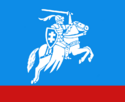Kalnija: Difference between revisions
No edit summary |
No edit summary |
||
| Line 2: | Line 2: | ||
|micronation = <!--yes if a micronation--> | |micronation = <!--yes if a micronation--> | ||
|conventional_long_name = Federation of Kalnija <!--Formal or official full name of the country in English--> | |conventional_long_name = Federation of Kalnija <!--Formal or official full name of the country in English--> | ||
|native_name = | |native_name = Kalnijano federacija <!--Country's name (usually full name) in its native language, hence in italics (double quotemarks)--> | ||
|common_name = Kalnija <!--Common name in English (used for wikilinks, captions, and to produce a default iso3166 code)--> | |common_name = Kalnija <!--Common name in English (used for wikilinks, captions, and to produce a default iso3166 code)--> | ||
|status = Independent <!--Status of country, especiallseful for micronations--> | |status = Independent <!--Status of country, especiallseful for micronations--> | ||
Revision as of 18:35, 2 December 2022
Federation of Kalnija Kalnijano federacija | |
|---|---|
| Motto: "Be Free or Die" | |
| Status | Independent |
| Capital and | Grobija |
| Recognised national languages | Kalnijan |
| Recognised regional languages | Raskian |
| Government | Federative Republic |
• Head of State | Elberonas Nikolevis |
| Population | |
• Estimate | 3,231,421 (2022) |
| GDP (nominal) | 14,770 estimate |
• Total | 47,753,321,122 |
The Republic of Kalnija is a nation located within Southern Argis. The country borders Baltica and Zuvikia. It is a heavily mountainous land, with very few fields or plains. Historically it has been an independent state that often clashed with the nearby Raskians and eventual Dolch. The Kalnijans originally inhabited what is modern day Northern Raskia, but were steadily pushed Northwards by the expansionary Raskian tribes. Modern day Kalnija almost entirely rests on the greater Kunijan Highlands, that stretch all the way into Northern Baltica. Kalnijas capital and largest city Grobija, rests on the Balandeli river that flows southwards into the Raskian Sveaja. The nation's creation is largely credited to Dzintars the Great (1441-1489), the first King of Kalnija. He would come to unify the scrambled Kalnijan tribes in an attempt to stave off further Invasion and subjugation from the Raskians. In the battle of Runner, he proved himself by slaying the then King of Raskia, King Yurgis II. Kalnijas place within the Kunijan Highlands would eventually prove to be its saving grace, as the Dolch (After their conquest of Raskia) would choose to not invade the lands of Kalnija as they thought they held no strategic purpose, coupled with various defeats that lead to the Dolch fleeing all lands North of the Bjurlan tributary that flowed into the Balandeli.
Etymology and Flag
The name “Kalnija” is believed to have originated from the word “Kalnas” meaning mountain, a prevalent term among much of the Southern Gentaric groups. Since the Kalnijans mainly inhabited the Northern Lands of the Kunjian Highlands, which are infamous for their mountains, the leading hypothesis is that the term was most likely used to just refer to “Mountain people”. Although the term may not have been exclusive to the Kalnijans as the lands were inhabited by multiple tribes, it most likely became a collective term after the unification of the territory under King Dzintars.
Kalnijas flag consists of a blue background, symbolising the vast horizon of the lands, with a red bottom banner symbolic of the blood spilled for the nation. The pinnacle figure of the flag (Referred to as Jonin) is a knight on a horse, representing Dzintar, his shield being adorned with the Baltican Double Cross as homage to the Catholic faith brought on by Dzantar. Although the symbol is often compared to the new Baltican Coat of Arms, which includes an image of the Hundersin, the two are entirely different.

